You’ve started to explore your personal style only to be hit in the face with “wear your lines” or “ I don’t think that compliments your lines very well” and… Initial confusion sets in, and the shame of actually asking “What the heck do you mean by lines!?” prevents you from ever clarifying the well-intentioned advice.
Well, I’ve got you covered. I’m trying to prevent you from screaming on your deathbed that if only you knew about style lines you might have loved your look.
So, let’s discuss.
Quick Note: This is a broad design term that is used in fashion design and styling as a whole. The way I will be discussing this is not in reference to any specific style system (like Kibbe for instance) but is certainly information that you can apply to a preferred system and your outfits. Many of these broad design terms are used similarly, so even if I don’t discuss your preferred system I realllllly think you will walk away from this article going “ya, that Gabrielle person was right, style lines are helpful” 😉
What are Style Lines? {how do they help with your personal style}
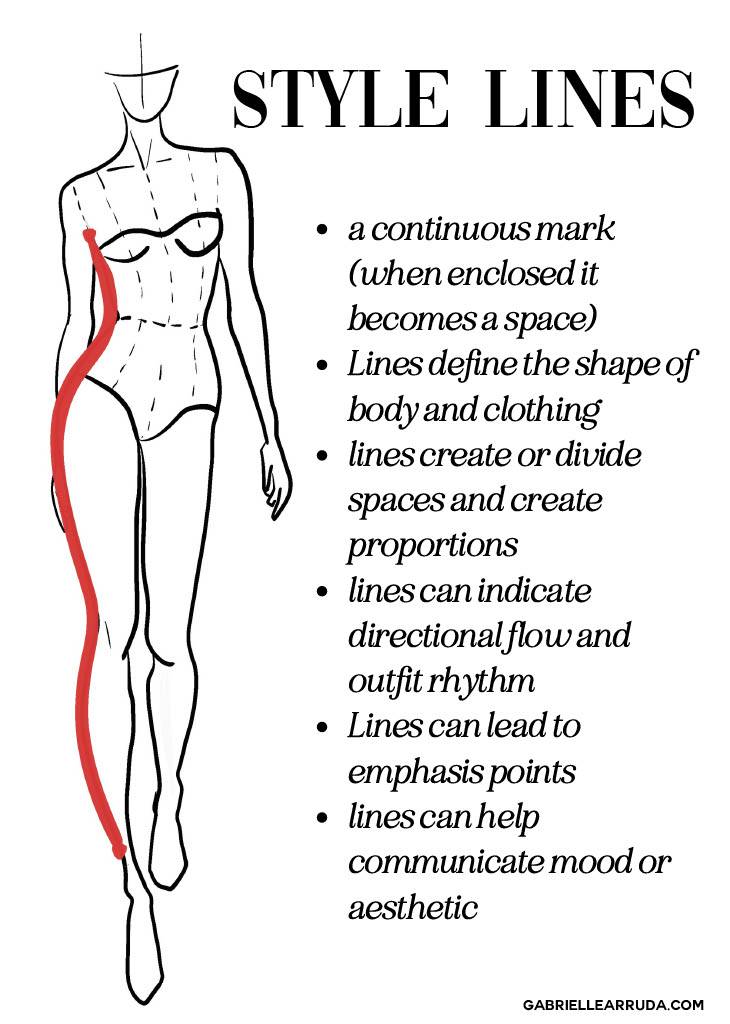
All designs, from fashion illustrations to outfits begin with a line (defined as one continuous mark).
When the continuous lines become enclosed, it creates a shape (another important design element that I can write an article on if you’d like).
We cannot have a design without lines, and because lines create shapes- well these two principles are the foundation of every garment.

By understanding your body shape and how style lines can complement or detract from it, you can choose clothing that highlights your best features and actually creates the look you were going for. It’s a base understanding that will serve you when you are building an outfit, shopping for an item, or even preparing for a big event.
The Function of Style Lines
- Lines define the shape of the body and clothing
- Lines can create or divide spaces, and they create different proportions overall
- Lines can indicate directional flow or impact the outfit’s rhythm
- Lines can lead to emphasis or focal points
- Lines can help communicate mood, aesthetics, vibes, or a visual effect
Defining Different Lines in Style
There are many different types of lines that can create the overall impact of your look. Let’s discuss and define the different options, so you can better acquaint yourself with these terms and start spotting them within your own garments and outfits.
First, let me specify that lines can be found both outside and within your garment.

Outlines: These are outside lines that are created by the body or the piece of clothing’s edge. This can also be referred to as the silhouette. In certain style systems (like Kibbe), the goal is for the clothing outlines to harmonize with the body outline.
Lines within the garment are either structural or decorative.

Structural Lines: Structural lines affect the construction of the garment and help shape the garment to create a specific silhouette. They include inner seam lines, darts, folds, tucks, pleats, gathers, or ruching.
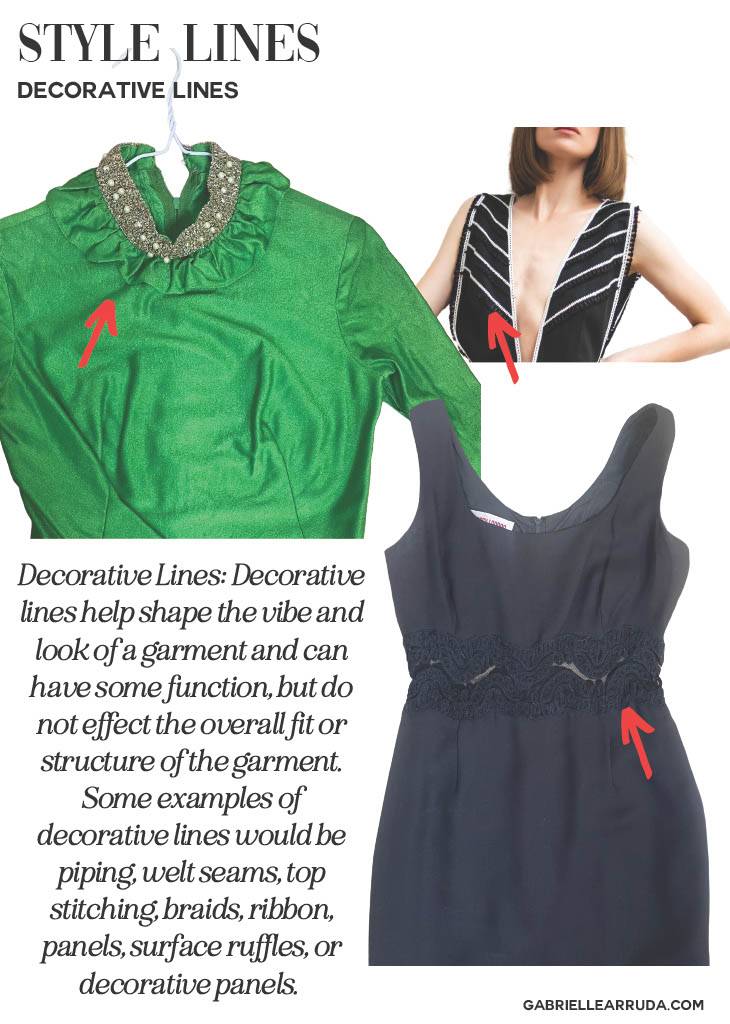
Decorative Lines: Decorative lines help shape the vibe and look of a garment and can have some function, but do not affect the overall fit or structure of the garment. Some examples of decorative lines would be piping, welt seams, top stitching, braids, ribbon, panels, surface ruffles, or decorative panels.
Types of Lines: Straight vs. Curved
To create a garment you must create a pattern, and that pattern is either straight or curved. ( This is measured on an overall effect and overall fit because every pattern will have some element of straight seams and curved seams in order to fit our bodies).
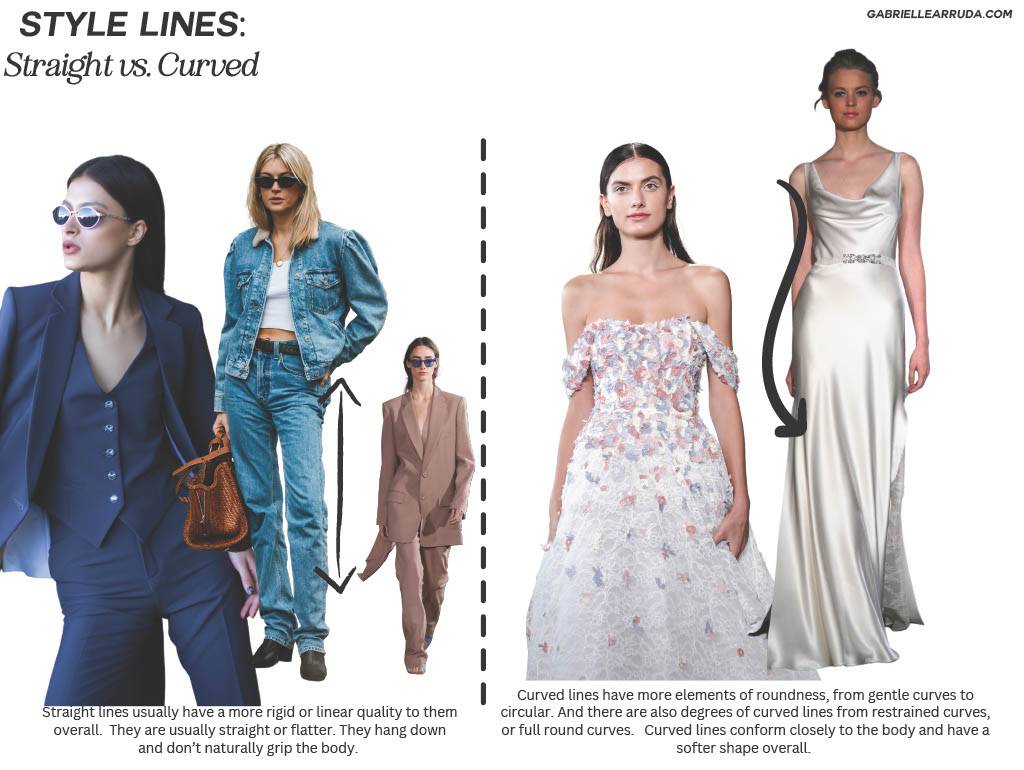
Straight lines usually have a more rigid or linear quality to them overall. They are usually straight or flatter. They hang down and don’t naturally grip the body.
Curved lines have more elements of roundness, from gentle curves to circular. And there are also degrees of curved lines from restrained curves or full round curves. Curved lines conform closely to the body and have a softer shape overall.
Restrained Curves vs. Full Round Curves
There is a subtle distinction between these two, but it’s helpful to keep it in mind. You’ll also find that many garments accommodate a multitude of lines and you’ll need to train your eye to determine the dominant line (we will get to that shortly).
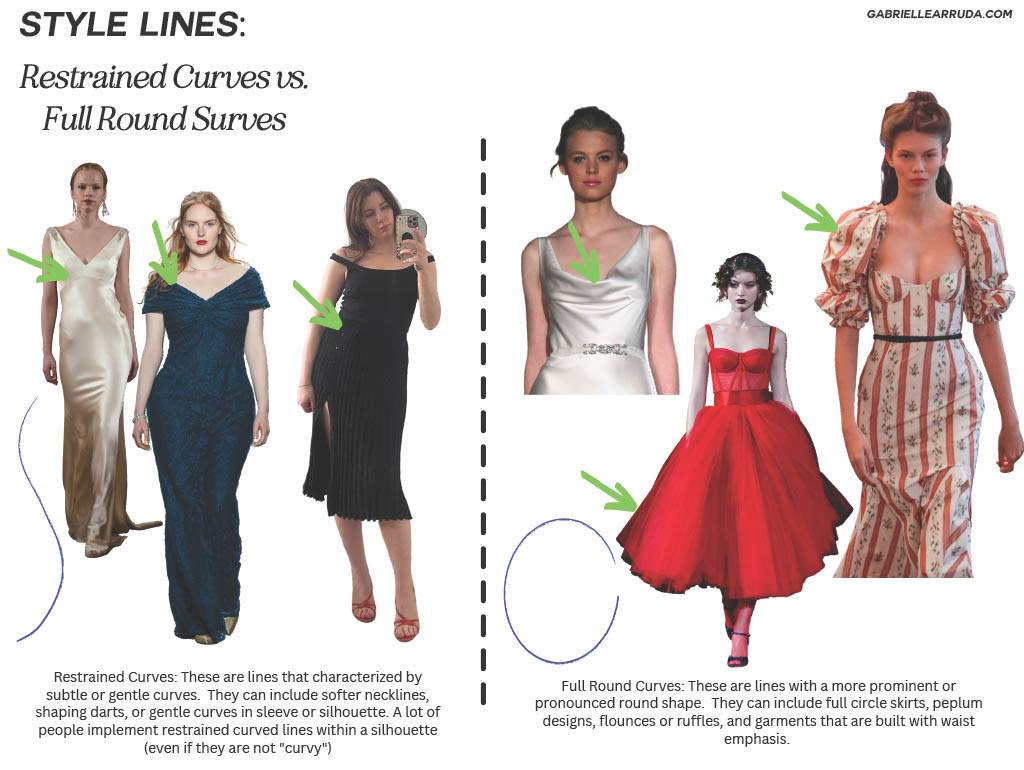
Restrained curved lines are characterized by subtle or gentle curves that are less pronounced and have a more restrained or controlled appearance. They create a sense of softness and elegance without being overly round. Some examples include:
Gentle necklines: Necklines with a slight curve, such as a gentle scoop or a soft V-neck, are considered restrained curved lines. They offer a feminine touch without being too deep or dramatic or overly rounded.
Subtle shaping darts: Darts that are gently curved rather than sharply angled create a restrained curved line. These darts help shape the garment to follow the contours of the body in a more subtle manner.
Gentle sleeve curves: Sleeve cap curves that are more rounded and less exaggerated fall under restrained curved lines. They provide a comfortable fit and a pleasing aesthetic without excessive volume or gathering.
Many people like to implement restrained curved garments in their outfits, even if they are not curvy.
Full round curves, on the other hand, feature more prominent and pronounced curves that create a bolder and more dramatic effect. These curves tend to be more noticeable and can be used to add volume, create dynamic shapes, or draw attention to specific areas. Some examples include:
Dramatic circular skirts: Skirts that have a full round shape, like circle skirts or gathered skirts, exhibit full round curves. They feature a lot of fabric and create a voluminous and flared silhouette.
Peplum designs: Peplums are flared or ruffled fabric sections attached at the waistline of a garment. They often incorporate full round curves to create a distinct and exaggerated shape.
Flounces or ruffles: Flounces and ruffles that have a wide and sweeping shape with a pronounced curve fall under full round curves. They add a sense of movement and playfulness to a garment.
Garments cut with waist emphasis: Garments that are built to highlight the waist and create a focal point in this area. The structure of the garment is built around this shape, it is not just a belt around the waist. This works exceptionally well for hourglass or curvy women. (It is also a staple for the Kibbe Theatrical Romantic and Romantic).
Line Direction
While the garment itself is composed of “lines”, we also notice the direction that these lines guide our eyes. And as we put together an outfit, how are these lines used in combination, including but not limited to the dominant line of the outfit and the length of the line?
Overall, we have three general line directions to choose from vertical, horizontal, and diagonal. And then we have variations or combinations.

Vertical lines: These lines go up and down (duh, right?)
- Vertical lines create length and allow the eye to travel seamlessly up and down
- Vertical lines can create more length and narrowness
- Wide vertical stripes can contradict the overall effect of vertical lines. Even though your eye still travels from top to bottom, it becomes distracted by the empty spaces horizontally
- Narrow vertical lines create a lengthening effect
Horizontal lines: These lines go across the body.
- Horizontal lines stop the eye from traveling up and down and instead draw the eye across
- People who have bodies that contain long vertical lines can shorten or widen their appearance by using too many horizontal disruptions.
- The width of lines and placement of lines can either highlight your body and harmonize with it or can create a contrasting effect.
Diagonal lines: These lines slant at an angle and depending on the angle can either mimic the effects of a vertical OR horizontal line.
- Diagonal lines are often noticed first and the direction or effect of the line has a secondary effect
- A combination of diagonal lines can create a variety of effects. For instance, a V-neck line is composed of diagonal lines that merge and draw the eye downward, mimicking the effects of a vertical line. Whereas a chevron pattern can mimic that of a horizontal line.
- Longer diagonal lines can add height or create more dramatic vertical movement.
- Less angled lines tend to draw the eye more horizontally
Ok, this may all seem very “basic” and like I’m just repeating information you already know in theory, but I challenge you to put it into practice while looking at clothes. Of course, we all know what a vertical or horizontal line is, but can we examine those lines in our outfits? That’s when the magic and design really start to be ingrained in your fashion perspective.
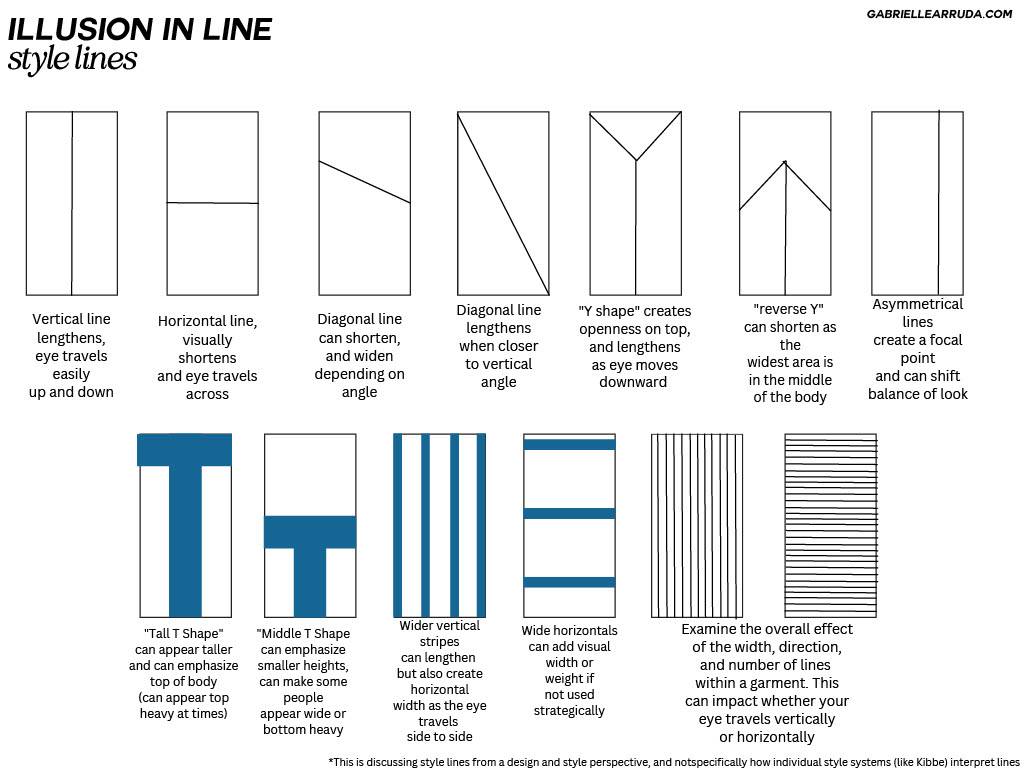
Arrangement of Lines
Now, you may have started to examine your outfits for style lines and become slightly confused. “But, Gaby, my outfit has multiple style lines and multiple directions, how can I be sure?”. Let’s talk about this.
Lines can be in opposition, in transition, or in radiation. ( I feel like I might be losing some of you already, but stay with me, this is where it starts to get good!)
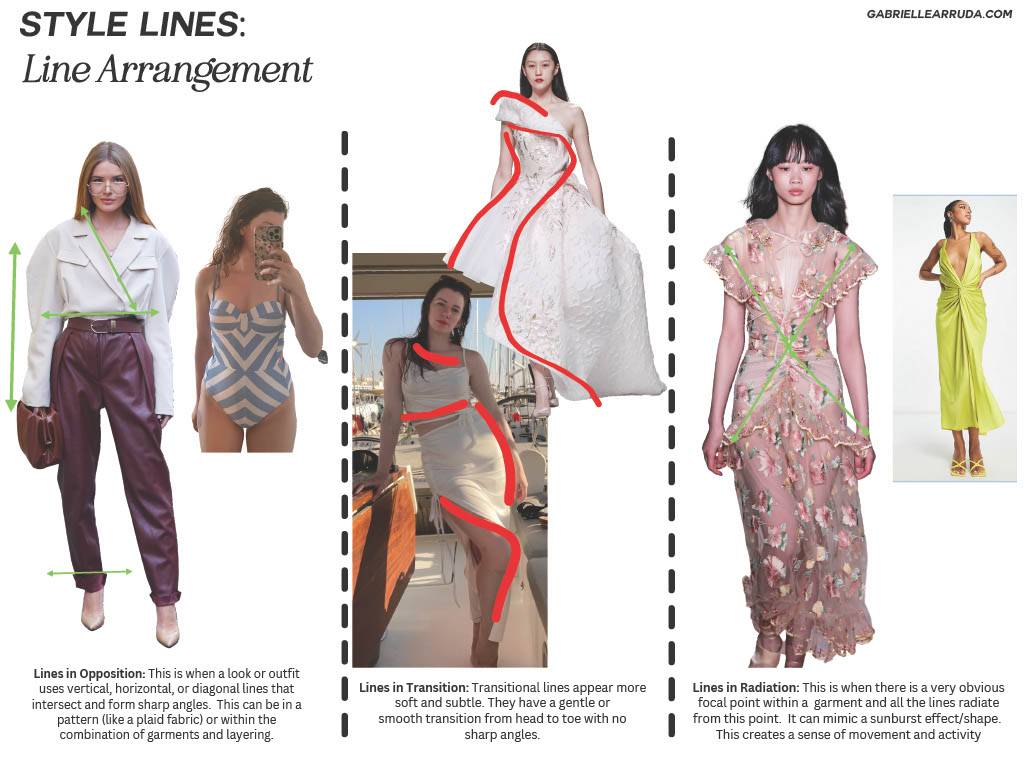
Lines in opposition: This is when the outfit uses vertical, horizontal, or diagonal lines that intersect and form sharp angles. This can be the lines within a garment ( like a plaid) or the combination of pieces. The overall effect of these lines creates a sharper, more severe look
Lines in Transition: Transitional lines appear more soft and subtle, it has a gentle or smoother transition from one style of line to the other. No harsh angles are created.
Lines in Radiation: This is when there is a very obvious focal point within the garment and all the lines radiate out from this point. Think of the shape of a sunburst. Because the lines are going all different directions and your eye travels around, it creates a sense of movement and activity.
Now all of these lines can be affected by their actual length within the garment, their thickness/thinness, how sharp or soft the angles or lines are, and their placement or dominance within the look.
A long sold line from neck to feet creates a stable, and graceful look. Whereas lots of shorter horizontal lines create a staccato, animated look
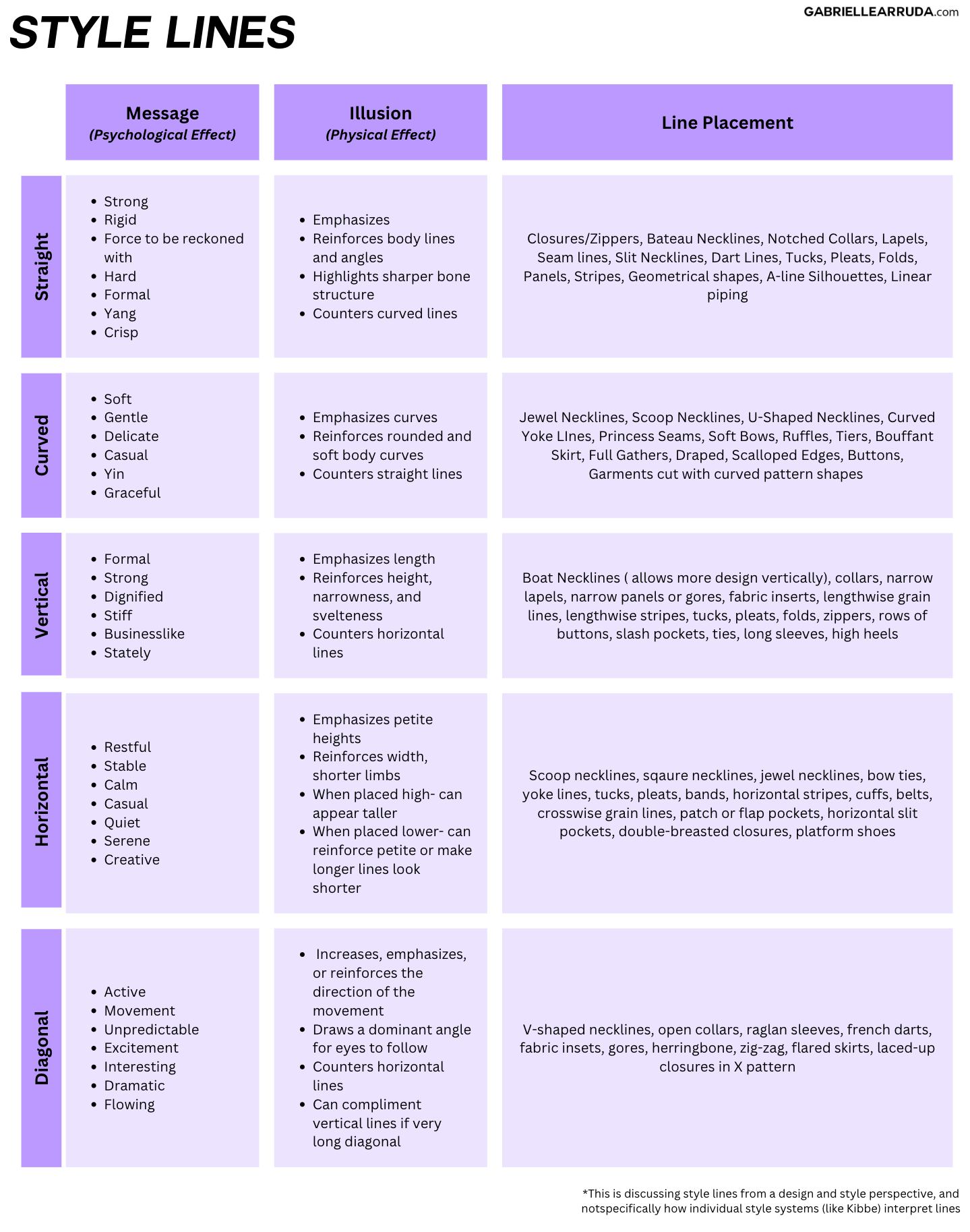
While it is important to understand lines in style, we must also examine the other elements and principles of design to properly understand how our outfit is expressing itself. This is often why broad generalized style rules can’t be universally applied. They may work for one outfit and fail in the next. But by examining the basic lines of your garment you can begin to understand the influences of each look and eventually how to evaluate an outfit from a holistic design perspective.
Squint test: Have trouble examining the lines of an outfit? Look at yourself in the mirror and squint, what do you see first? What is popping out at you immediately?
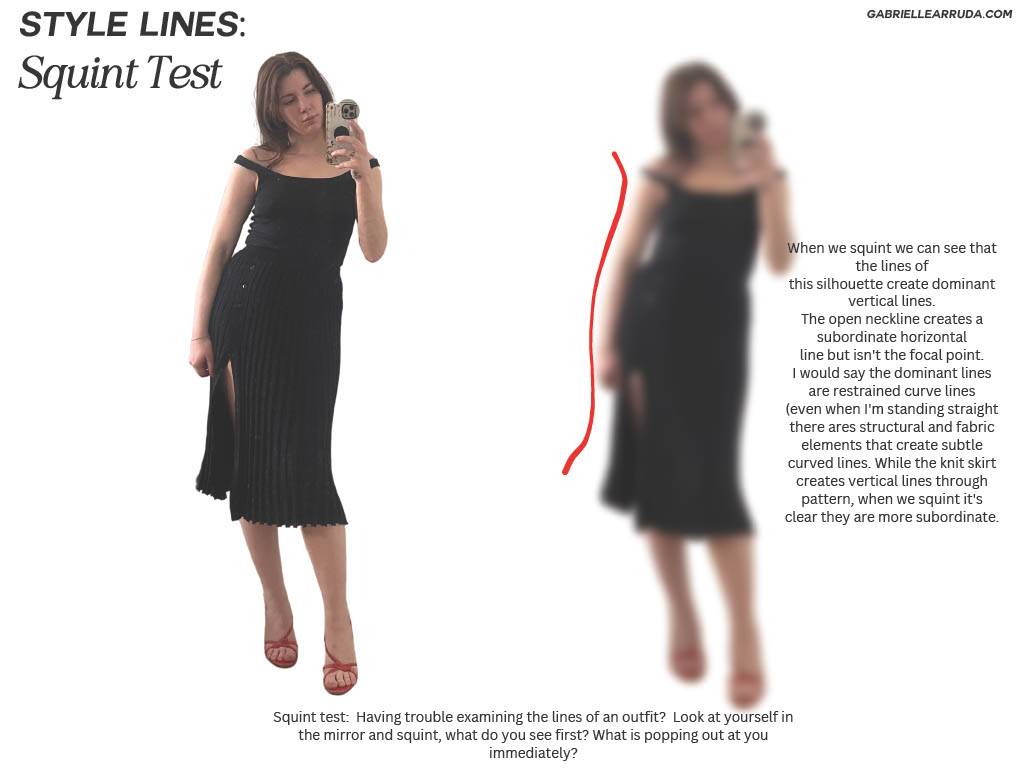
Harmony In Style Lines
You are most likely going to have more than one line within your outfits, and it can take some training to understand how you’d like to merge these lines for your chosen outfit goal.
In order to do this you must first consider where you are wearing this outfit. An outfit for a gala versus an outfit for a formal business office is going to generally use line harmonies differently.
And you must start to be aware of where you are using these lines and what they are communicating. And whether or not the lines in combination are clashing.
Even if you choose all straight lines or all curved lines, you must consider the overall balance and harmony of the looks.
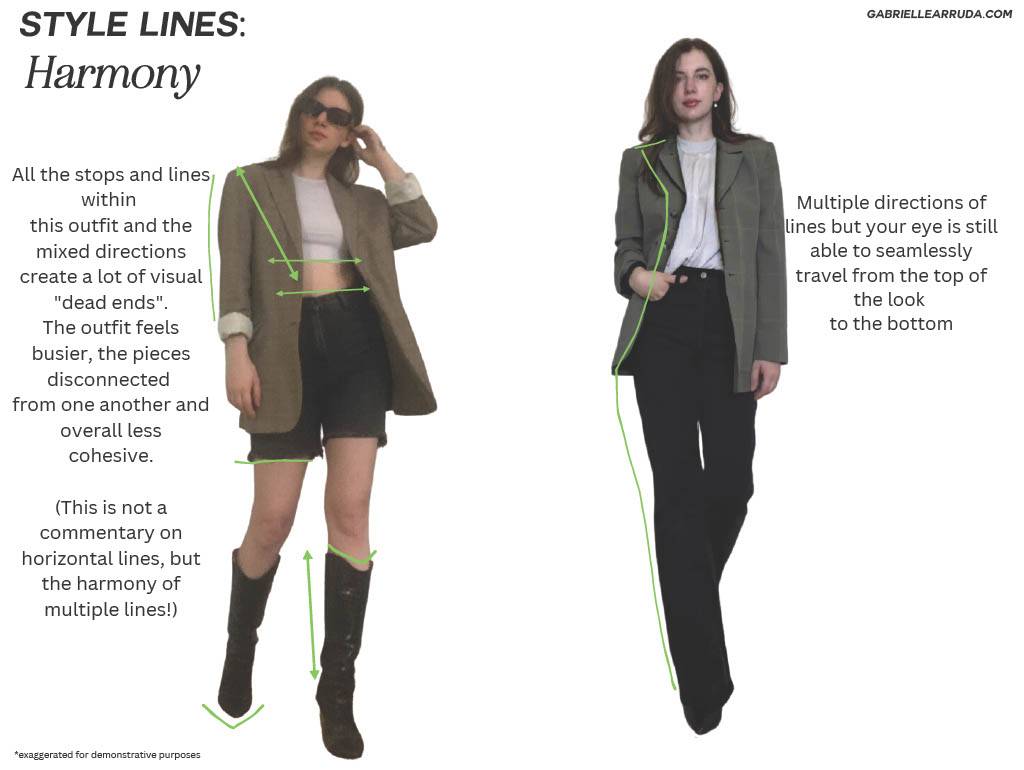
As you can see in my two outfits above. The first outfit has a lot of straight lines and a combination of line directions, but there are too many of them at different angles and the eye doesn’t know where to travel. It keeps getting stuck. It’s a like a car that has hit a bunch of dead ends.
Whereas the second look has a clear overall dominant line that travels from top to bottom. It isn’t monochrome but still creates a vertical impact. And even if you focus on a horizontal line outfit, you need to examine how the outfit flows together, and how your eye is taking in the outfit.
Start by examining how your lines are interacting with one another and if the illusion or message contradicts one another. Sometimes a contrasted approach can have a “cool-girl” effect, but that’s a very advanced outfit-building technique, and I would first start by understanding your basic lines before trying to create such a vibe.
How do Stripes Impact Your Lines?
One would think this is obvious but the placement, width, and spacing of stripes can dramatically impact whether or not an outfit feels more vertical or feels more horizontal.
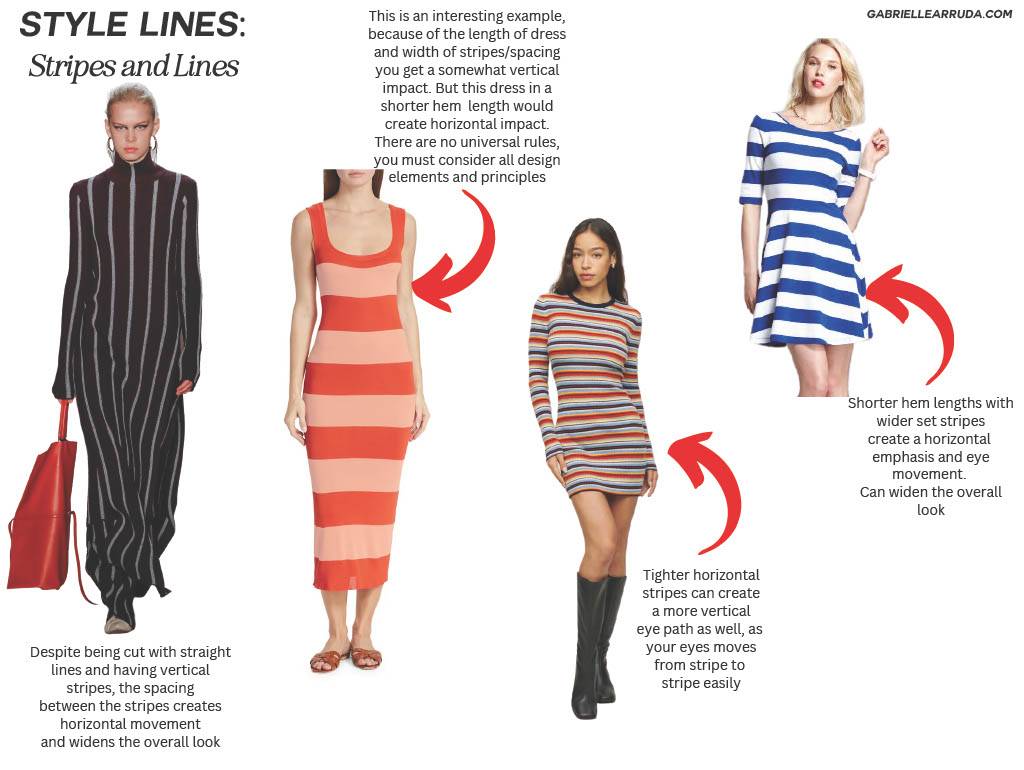
This leads me to…
Dominant vs. Subordinate Style lines
Your overall outfit needs a dominant line. Remember my example of the outfits above that had too many dead ends? We want our outfits to have some flow to them, and visual harmony or rhythm.
This does not mean that you only include one style line in your outfit, but that you pair style lines to create a dominant effect. Whether you opt for dominant vertical, horizontal, or diagonal lines is up to you.
There may be other lines in your outfit that are created by outfit breaks, design elements, or layering pieces, but we want those lines to have a subordinate or descending-degree effect.
The more you understand your style lines the more you can successfully challenge these ideas and combinations, but again it takes practice and a good eye for design to do this successfully. And there are no universal style rules to be applied here as it depends on the person’s body, lifestyle, and personality.
We want to create interest in our outfits and flow but still maintain the mood we are going for within each outfit.
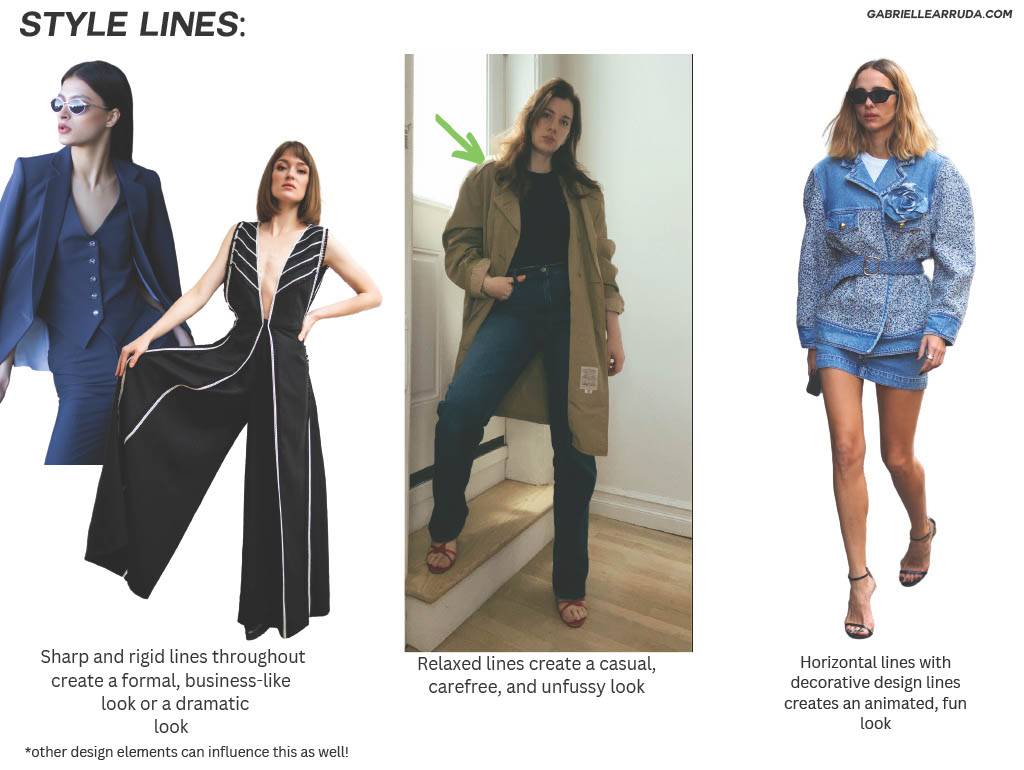
See how the above looks use lines to create different moods. If you’re curious, you can also use these lines in conjunction with your Kibbe Image Identity or your Kitchener Style Essences.
What do I do with all this information?
Understanding the lines of your clothes can help you achieve the look you are going for, and communicate the message you’d like. Here are some questions to ask yourself in order to choose the right style lines for you.
- Are your style lines harmonizing with your body’s natural lines?
- Are you choosing lines that are appropriate and reflect the mood of the activity, event, or occasion?
- Do these style lines reflect your personality and the adjectives to which you would like to be perceived?
- Do these style lines mimic the natural lines and shapes of your face?
- Are these style lines compatible with your current closet?
Is it a basic piece or a costume piece?
In this video, I discuss wardrobe strategies to balance out the variety of your closet and create a closet that can mix and match easily. The lines of a garment can help you determine if it is a basic piece or a costume piece.
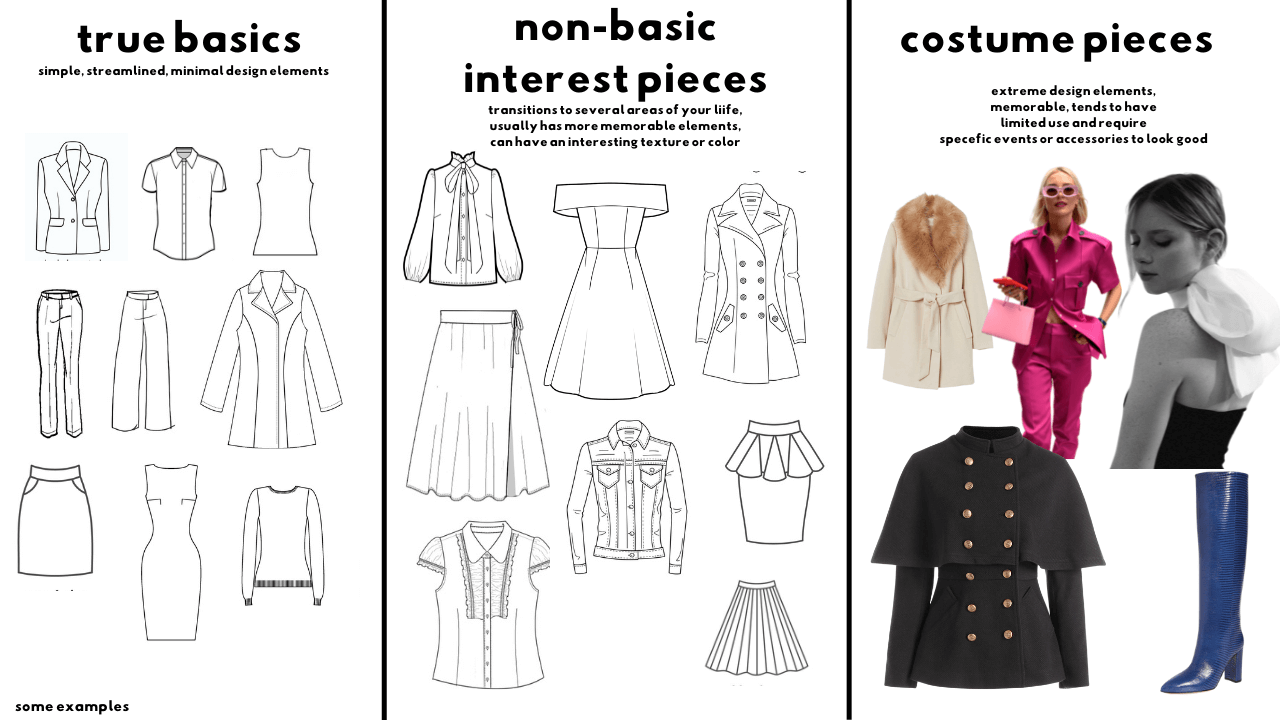
Simple garments with fewer structural elements and little to no decorative elements would be basic pieces. Pieces with smaller decorative elements are non-basic interest pieces, and pieces with lots of decorative elements are costume pieces.
Your wardrobe should have a bit of each to be properly balanced and create the most flexibility. This also allows for more line combinations.
Combining too many costume pieces in an outfit can create a chaotic look, and needs to be done with a very astute design eye.
Want to see how your garments can be dissected? Examine a garment based on the following attributes.
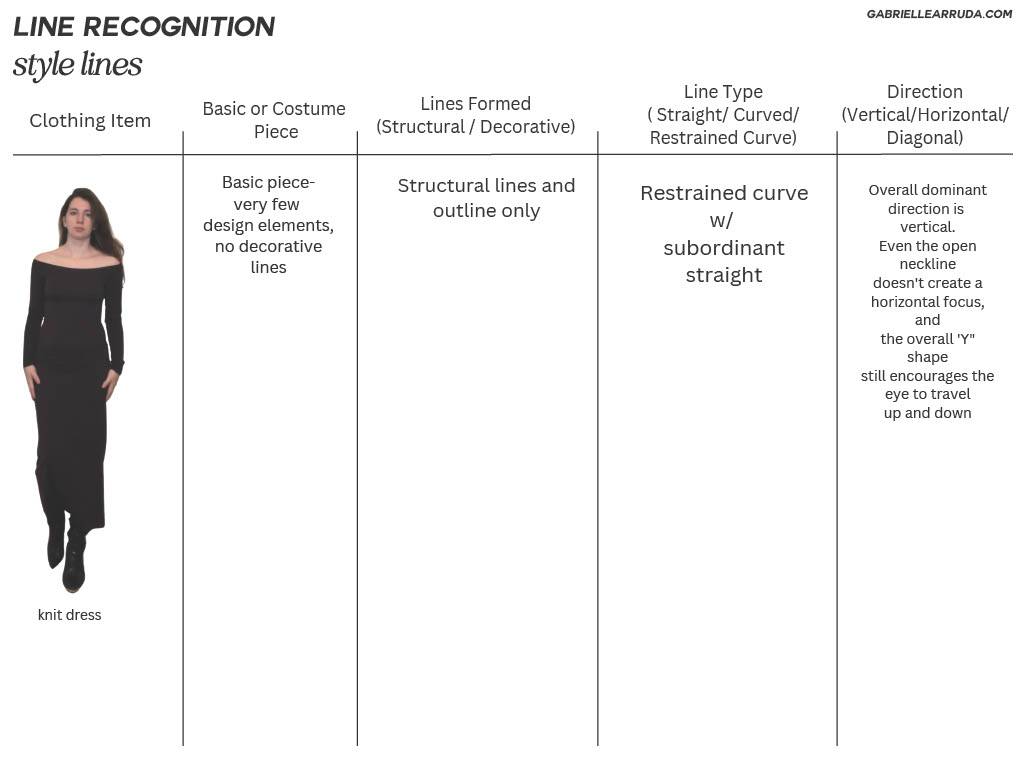
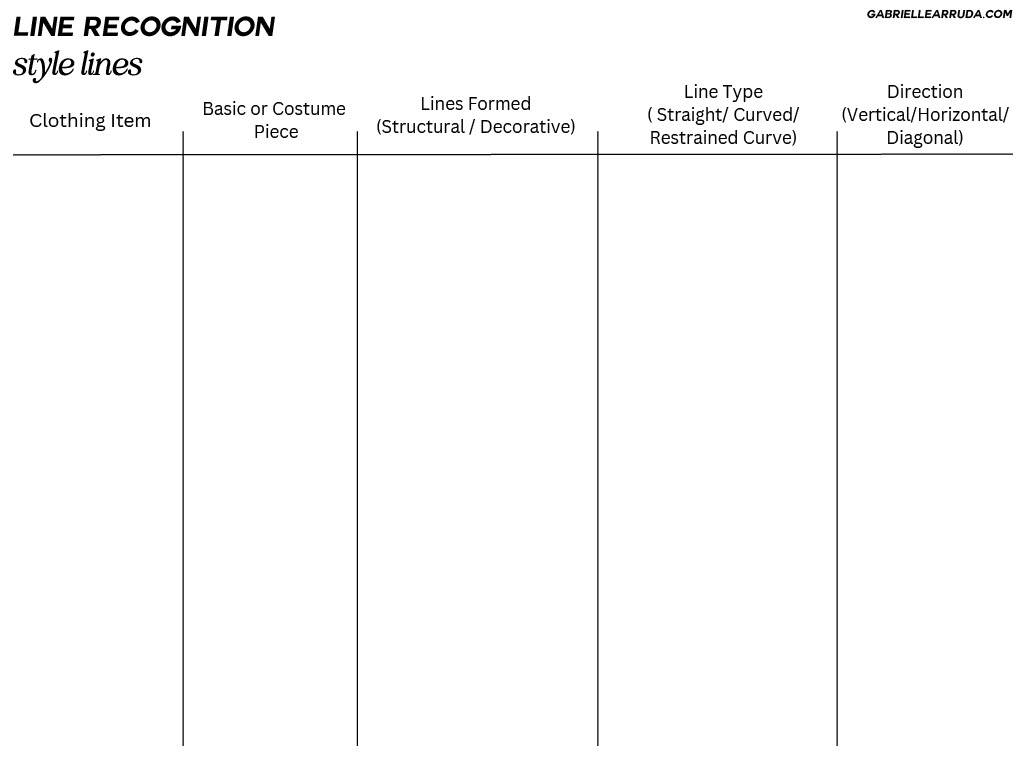
You can fill out the chart for your favorite and least favorite garments in your closet and start exploring whether or not you have a preference in your lines. This can also highlight if your wardrobe is unbalanced, or if you have too many decorative lines.
Put It Into Practice
Understanding style lines and theory is a great first step, but you need to get acquainted with how you can apply that to your own everyday outfits.
Try breaking down some of your outfits and seeing what style lines they are using and the overall mood or vibe they are communicating. Is that lining up with your style goals?
You can see how I’ve done this in the example below.
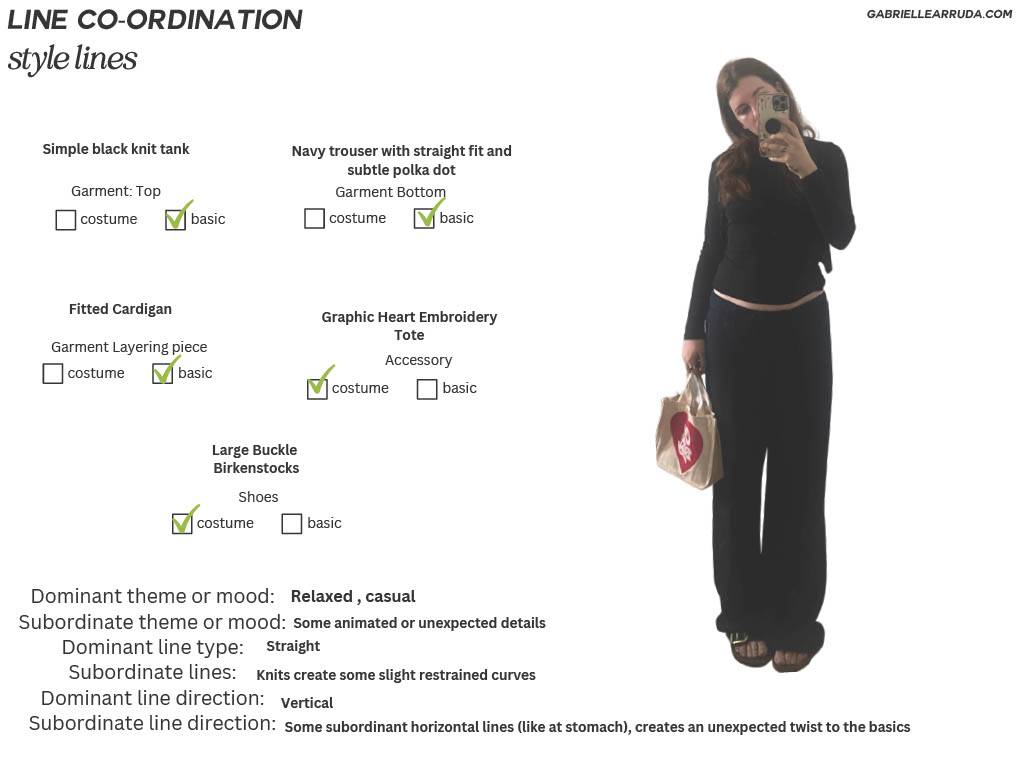

The easiest way to start understanding how you naturally use lines or how you like to combine lines is to take daily outfit photos. After you’ve collected some “style data” in the form of daily outfit photos you can look for overall dominant trends and the effects these lines are communicating.
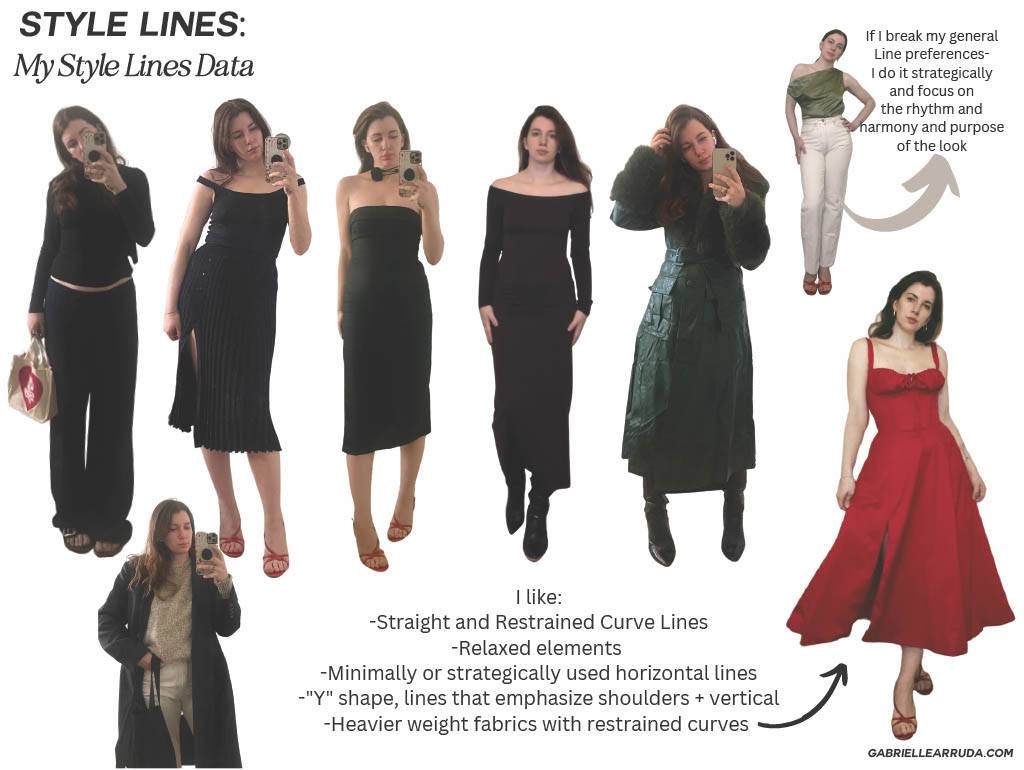
If you’re trying to understand style lines further, start by creating a Pinterest board with style lines you like. Then start to analyze them and jot down what elements the outfit is using in terms of lines. Over time you will train your eye to identify the different principles and how they can be used, and you may even find yourself tossing out some looks you liked previously.
Embrace the evolution of your style and your understanding of how you want YOUR lines to work with YOUR style and YOUR body.
I hope this helps you find strength through style!
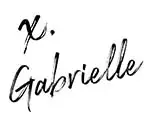
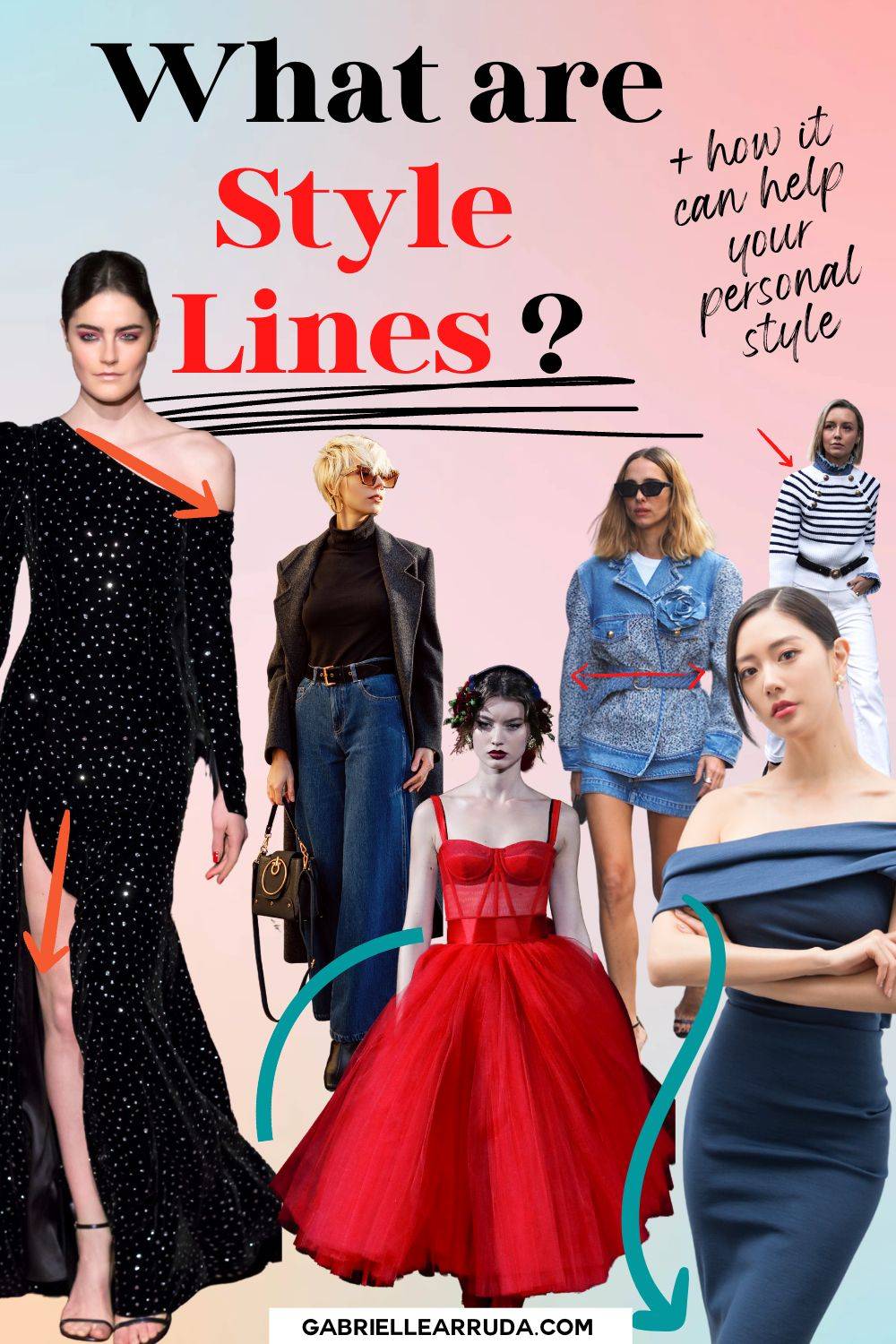

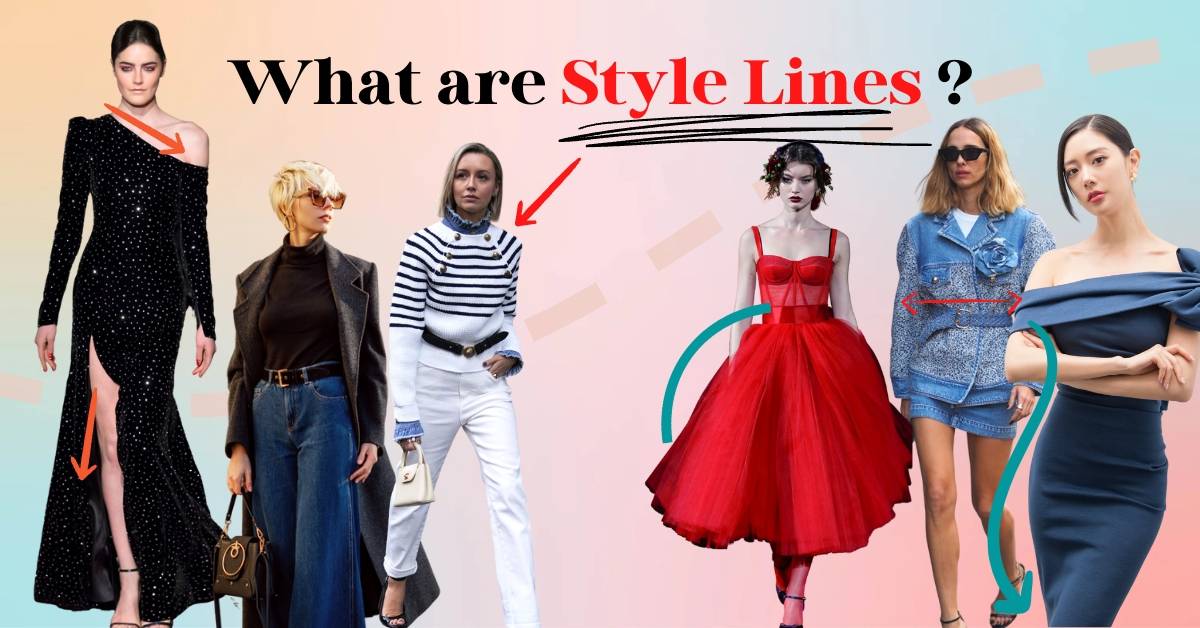
Sophie
Thursday 14th of September 2023
This article is super useful and eye-opening. I really like the concept of both honoring your body's natural lines, but also honering what vibe/personality you want to project. Just a quick question: Would your own body's outer lines give you an idea of your best clothing lines and your facial lines an idea of your best details within those clothes? Or how would you use your facial lines as a guide?
Andrea
Wednesday 13th of September 2023
I am petite (under 5'1") with a full bust and a rectangle body. Gamine lines should be short, but I would prefer to elongate and softly drape my figure. I am looking forward to learning more!
anna
Thursday 20th of July 2023
this article is genius! is there a relationship between your line preference and your kitchener essences/kibbe type? for ex, as a kibbe romantic, i really LOVE full round curve lines, but i struggle with horizontal lines (even though i love them).
Lyfia
Saturday 8th of July 2023
Genius article, I’m going to be coming back to this one for sure! This sort of concrete style theory is so helpful to those of us who don’t have that natural artistic eye!
Gabrielle Arruda
Saturday 8th of July 2023
I'm so glad it's helpful!!
Natalie
Wednesday 24th of May 2023
This is really helpful! I found that I had been kind of thinking about this concept but couldn't quite put my finger on it. Thanks for helping me get a better grasp